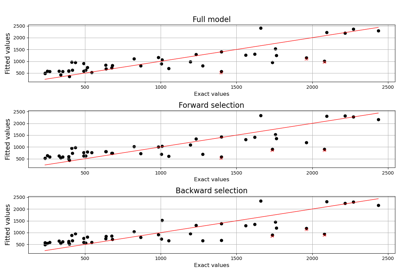LinearModelStepwiseAlgorithm¶
- class LinearModelStepwiseAlgorithm(*args)¶
Stepwise linear model algorithm.
- Parameters:
- inputSample, outputSample2-d sequence of float
The input and output samples of a model.
- basis
Basis Functional basis to estimate the trend.
- minimalIndicessequence of int
The indices of minimal model
- directionint, default=FORWARD
BACKWARD, FORWARD or BOTH.
- startIndicessequence of int, default=[]
The indices of start model used for the stepwise regression method. Can only be specified in BOTH mode.
Methods
Accessor to the object's name.
Accessor to the direction.
Accessor to the input sample.
Accessor to the maximum iteration number.
getName()Accessor to the object's name.
Accessor to the output sample.
Accessor to the penalty.
Accessor to the result.
hasName()Test if the object is named.
run()Run the algorithm.
setMaximumIterationNumber(maximumIteration)Accessor to the maximum iteration number.
setName(name)Accessor to the object's name.
setPenalty(penalty)Accessor to the penalty.
See also
Notes
The objective is to select the best linear regression model by using the stepwise method. Starting from the basis and minimalIndices, the stepwise strategy consists in adding basis elements (FORWARD), dropping some (BACKWARD) or adding and dropping (BOTH strategy) some elements. At each step, we get a model. We compute the corresponding penalty (BIC or AIC) and we continue repeatedly this process until the penalty could not be improved or the maximum iterations number is reached. Finally we get a regression model between the scalar variable
and the
-dimensional one
writes as follows:
where
is the residual, supposed to follow the standard Normal distribution,
the i-th element of the basis.
Examples
Definition of the data set
>>> import openturns as ot >>> ot.RandomGenerator.SetSeed(0) >>> distribution = ot.Normal() >>> func = ot.SymbolicFunction(['x1','x2', 'x3'], ['x1 + x2 + sin(x2 * 2 * pi_)/5 + 1e-3 * x3']) >>> dimension = 3 >>> distribution = ot.JointDistribution([ot.Normal()]*dimension) >>> input_sample = distribution.getSample(20) >>> output_sample = func(input_sample)
Creation of a basis
>>> functions = [] >>> input_description = ['x1','x2', 'x3'] >>> functions.append(ot.SymbolicFunction(input_description, ['1.0'])) #Constant term >>> for i in range(dimension): #Linear terms ... functions.append(ot.SymbolicFunction(input_description, [input_description[i]])) >>> basis = ot.Basis(functions)
Stepwise regression
>>> minimalIndices = [0] >>> direction = ot.LinearModelStepwiseAlgorithm.BACKWARD >>> penalty = 2.0 #Akaike Information Criterion, log(n) can be used for a BIC >>> algo_forward = ot.LinearModelStepwiseAlgorithm(input_sample, output_sample, basis, minimalIndices, direction) >>> algo_forward.setPenalty(penalty) >>> algo_forward.run() >>> result_forward = algo_forward.getResult()
- __init__(*args)¶
- getClassName()¶
Accessor to the object’s name.
- Returns:
- class_namestr
The object class name (object.__class__.__name__).
- getDirection()¶
Accessor to the direction.
- Returns:
- directionint
Direction.
- getMaximumIterationNumber()¶
Accessor to the maximum iteration number.
- Returns:
- maximum_iterationint
Maximum number of iterations.
- getName()¶
Accessor to the object’s name.
- Returns:
- namestr
The name of the object.
- getPenalty()¶
Accessor to the penalty.
- Returns:
- penaltyfloat
Penalty.
- getResult()¶
Accessor to the result.
- Returns:
- result
LinearModelResult The result.
- result
- hasName()¶
Test if the object is named.
- Returns:
- hasNamebool
True if the name is not empty.
- run()¶
Run the algorithm.
- setMaximumIterationNumber(maximumIteration)¶
Accessor to the maximum iteration number.
- Parameters:
- maximum_iterationint
The maximum number of iterations of the stepwise regression method.
- setName(name)¶
Accessor to the object’s name.
- Parameters:
- namestr
The name of the object.
- setPenalty(penalty)¶
Accessor to the penalty.
- Parameters:
- penaltypositive float
The multiple of the degrees of freedom used for the penalty of the stepwise regression method:
2 Akaike information criterion (AIC) (default)
log(n) Bayesian information criterion (BIC)
 OpenTURNS
OpenTURNS
